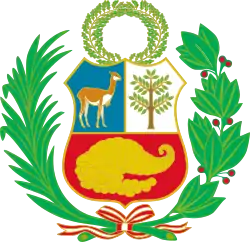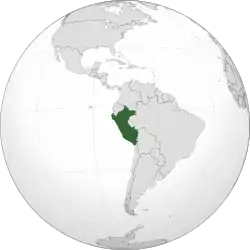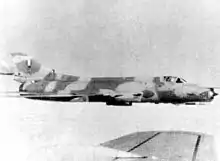Peruvian Military Junta of 1968-1980
The Peruvian Military Junta of 1968–1980 or Revolutionary Government of the Armed Forces was a Military junta in Peru. The Revolutionary Government of the Armed Forces was led by Juan Velasco Alvarado.
Revolutionary Government of the Armed Forces Gobierno Revolucionario de las Fuerzas Armadas | |||||||||
|---|---|---|---|---|---|---|---|---|---|
| 1968–1980 | |||||||||
 Flag (1968–80)
 Coat of arms (1968–1980)
| |||||||||
Anthem: Himno Nacional de Perú | |||||||||
 | |||||||||
| Capital | Lima | ||||||||
| Common languages | Peruvian Spanish Quechua | ||||||||
| Religion | Roman Catholic | ||||||||
| Demonym(s) | Peruvian | ||||||||
| Government | Military junta | ||||||||
| President | |||||||||
| Historical era | Cold War | ||||||||
• Coup d'état removes Fernando Belaunde from power | 1968 | ||||||||
• Disestablished | 1980 | ||||||||
| Currency | Sol | ||||||||
| ISO 3166 code | PE | ||||||||
| |||||||||
Coup d'etat
In 1968 the Ejército del Perú led by Juan Velasco Alvarado led a Coup d'etat against President Fernando Belaunde's government. The end result was that Velasco's forces took power in 1968 and shifted more to a soviet style dictatorship.
Military revolution and dictatorship (1968–1975)
The coup leaders named their administration the Revolutionary Government of the Armed Forces, with Velasco at its helm as President. Velasco's administration articulated a desire to give justice to the poor through a regime of nationalization known as Peruanismo. Velasco's rule was characterized by left-leaning policies, which aimed to create a strong national industry to increase the international independence of Peru. To that end, he nationalised entire industries, expropriated companies in a wide range of activities from fisheries to mining to telecommunications to power production and consolidated them into single industry-centric government-run entities (PescaPeru, MineroPeru, Petroperú, SiderPeru,Centromin Peru, ElectroPeru, Enapu, EnatruPeru, Enafer, Compañia Peruana de Telefonos, EntelPeru, Correos del Peru, etc.), and increased government control over economic activity by enforcing those entities as monopolies and disincentivized private activity in those sectors. Most reforms were planned by left-leaning intellectuals of the time, and some of them successfully improved the Peruvian quality of life.
A root and branch education reform was in march looking to include all Peruvians and move them towards to a new national thinking and feeling; the poor and the most excluded were prioritized in this system and the Día del Indio or Peruvian Indian's day name was changed to Día del Campesino or Peruvian Peasant's day every June 24, a traditional holiday of the land, the day of winter solstice.
The education reform of 1972 provided for bilingual education for the indigenous people of the Andes and the Amazon, which consisted nearly half of the population. In 1975, the Velasco government enacted a law making Quechua an official language of Peru equal to Spanish. Thus, Peru was the first Latin American country to officialize an indigenous language. However, this law was never enforced and ceased to be valid when the 1979 constitution became effective, according to which Quechua and Aymara are official only where they predominate, as mandated by law – a law that was never enacted.[1]
Peruanismo was also characterized by authoritarianism, as the administration grew away from tolerating any level of dissent, periodically jailing, deporting and harassing suspected political opponents and repeatedly closing and censoring broadcast and print news media, finally expropriating all of the newspapers in 1974 and sending the publishers into exile.
A cornerstone of Velasco's political and economic strategy was the implementation by dictate of an agrarian reform program to expropriate farms and diversify land ownership. In its first ten years in power, the Revolutionary Government of the Armed Forces (GRFA) expropriated 15,000 properties (totaling nine million hectares) and benefited some 300,000 families.[2] The former landlords who opposed this program believed that they did not receive adequate compensation for their confiscated assets and lamented that the state officials and peasant beneficiaries mismanaged their properties after the expropriation.[3]
Foreign Relations
In foreign policy, in contrast with his 1970s Latin American contemporaries, which were mostly right-wing military dictatorships, Velasco pursued a partnership with communist countries, beginning with Czechoslovakia and Yugoslavia.[4] By 1969 he established warm relations with the Soviet bloc, tightening relations with Cuba and Fidel Castro as well as Romania and Nicolae Ceaușescu and undertaking major purchases of Soviet military hardware.
Velasco was greatly influenced by socialist Yugoslavia's policies of self-management and worked with Yugoslav economist Edvard Kardelj to help implement similar policies in Peru. Yugoslavia aided the Junta financially and diplomatically, and the two nations remained close allies.[5]
Relations between the United States and Peru were tense and even hostile, as soon as General Velasco and his junta took power.
Just five days after Velasco seized power in 1968, the General began the nationalization of the Peruvian Economy with the expropriation and nationalization of the American International Petroleum Company (IPC) oil fields located in the northern Peruvian oil port and refinery of Talara, Piura, near the Peruvian border with Ecuador, Piura, being the region where Velasco was born.
IPC was a subsidiary of Standard Oil, and although the claims over the IPC were ultimately resolved in negotiations between the two governments, the US after this seizure no longer considered Peru an ally or a friendly country. Instead, the CIA started to organize plans to destabilize and to overthrow General Velasco.
US-Peru disagreements continued over a broad range of issues including even Peru's claim to a 200-nautical-mile (370 km) fishing limit that resulted in the seizure of several US commercial fishing boats and the expropriation of the American copper mining company Cerro de Pasco Corporation.
However, in spite of these provocations, the U.S. responded immediately with humanitarian aid in 1970, when an earthquake killed about 50,000 persons and left over 600,000 homeless.

Military
Velasco's army was one of the strongest armies in Latin America. It consisted of the Ejército del Perú, Fuerza Aérea del Perú and Marina de Guerra del Perú.
it is estimated that from 1970 to 1975 Peru spent up to US$2 Billion (roughly US$20 Billion in 2010's valuation) on Soviet armament.[6] According to various sources Velasco's government bought between 600 and 1200 T-55 Main Battle Tanks, APCs, 60 to 90 Sukhoi 22 warplanes, 500,000 assault rifles, and even considered the purchase of a British carrier Centaur-class light fleet carrier HMS Bulwark.[6]
The Ejército del Perú had 1200 units in total raging from T-55 Main Battle Tanks and APCs. The Fuerza Aérea del Perú had 90 Sukhoi 22 warplanes for combat and Antonov An-26 and An-32 transport aircraft, as well as Mil Mi-8, Mi-17, Mi-25 and Mi-26 helicopters. The Marina de Guerra del Perú's flagship was the BAP Almirante Grau (CLM-81) received from the Netherlands. The Peruvian Navy mirrored that of Chile.
References
- David Brisson: Quechua Education in Peru. The Theory-Context Mergence Approach, pp. 13–14.
- Enrique Mayer, Ugly Stories of the Peruvian Agrarian Reform. Durham: Duke University Press, 2009.
- Enrique Mayer, Ugly Stories of the Peruvian Agrarian Reform. Durham:Duke University Press, 2009.
- Walter, Richard J. Peru and the United States, 1960-1975: How Their Ambassadors Managed Foreign Relations in a Turbulent Era. Pennsylvania State University Press, 2010.
- Kasza, Gregory James. The Conscription Society: Administered Mass Organizations. Yale University Press, 1995.
- Gerald R. Ford Presidential Library and Museum. KISSINGER, HENRY